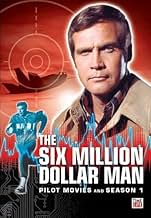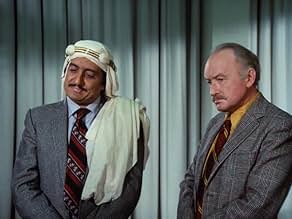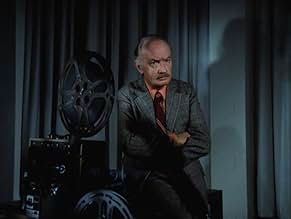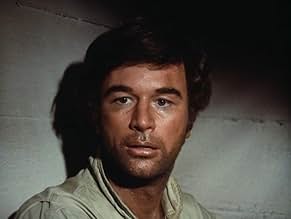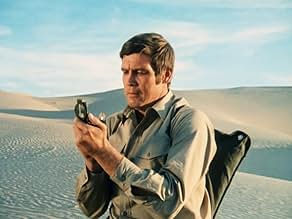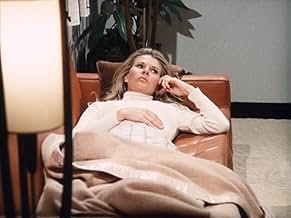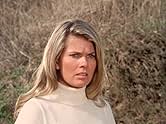Der sechs Millionen Dollar Mann
Originaltitel: The Six Million Dollar Man
IMDb-BEWERTUNG
6,9/10
5411
IHRE BEWERTUNG
Füge eine Handlung in deiner Sprache hinzuAfter an astronaut and test pilot is catastrophically mutilated in a test plane crash, he is rebuilt and equipped with nuclear powered bionic limbs and implants.After an astronaut and test pilot is catastrophically mutilated in a test plane crash, he is rebuilt and equipped with nuclear powered bionic limbs and implants.After an astronaut and test pilot is catastrophically mutilated in a test plane crash, he is rebuilt and equipped with nuclear powered bionic limbs and implants.
- Auszeichnungen
- 1 Nominierung insgesamt
Charles Robinson
- Prisoner
- (as Charles Knox Robinson)
George D. Wallace
- General
- (as George Wallace)
Olan Soule
- Saltillo
- (as Olan Soulé)
Claire Brennen
- OSI Committee Member
- (Nicht genannt)
Eddie Garrett
- Security Guard outside Steve's room
- (Nicht genannt)
Empfohlene Bewertungen
I just watched a show on the History Channel talking about Star trek tech and how it inspired scientists and engineers or got then interested in science. It would be interesting to see The History Channel do The same for TSMDM and show bionic tech and talk to doctors and engineers who were inspired by the show to create real bionic arms legs and eyes or the doctors who treat patients with artificial limbs and eyes and ears. In fact I just remembered an episode when Doctor Rudy Wells created a bionic heart used to transplant into some important world leader who if he died would leave a power vacuum which would lead to disaster
This was truly a great series to watch growing up. Who wouldn't want super strength and super speed? I remember in the movie or maybe it was one of the early shows where there was a guy in a rural area (farm maybe?) who looks out over a flat field and sees a man tearing up the road. In the early days, Steve ran pretty fast, as opposed to the slow motion used later.
The movie was set up very well. A man has an internal battle going on when he loses both his legs, his right arm and his left eye. He didn't want to become a machine. Then, later as he is getting used to the idea of being "bionic," he sees an accident and goes to rescue a little girl who is trapped inside. As he rips the door off, and reaches for the pinned girl, something in the car tears a part of his arm. After rescuing the girl, the mother see the arm and screams. So much for being the hero. I wished they would have kept that conflict going a little while longer. Not overplay it...Just keep it going. But, they weren't sure the show would be picked up, so they resolved the conflict...
The movie was set up very well. A man has an internal battle going on when he loses both his legs, his right arm and his left eye. He didn't want to become a machine. Then, later as he is getting used to the idea of being "bionic," he sees an accident and goes to rescue a little girl who is trapped inside. As he rips the door off, and reaches for the pinned girl, something in the car tears a part of his arm. After rescuing the girl, the mother see the arm and screams. So much for being the hero. I wished they would have kept that conflict going a little while longer. Not overplay it...Just keep it going. But, they weren't sure the show would be picked up, so they resolved the conflict...
I was reading the April 30 issue of This is True (http://www.thisistrue.com/) and found out that this TV series was in fact based on the story of Bruce A. Peterson, a NASA test pilot. The opening credits featured his accident while testing a lifting body concept.
His biography is in (http://www.nasa.gov/centers/dryden/news/ Biographies/Pilots/bd-dfrc-p012.html). Please enter the whole web address as one continuous word (delete the space before Biographies). The comment rules don't allow me to send a very long word.
I remember watching some of the episodes when I was really little. My friends would try to imitate Steve's actions when he ran or jumped, complete with that distinctive 'Bionic' sound.
His biography is in (http://www.nasa.gov/centers/dryden/news/ Biographies/Pilots/bd-dfrc-p012.html). Please enter the whole web address as one continuous word (delete the space before Biographies). The comment rules don't allow me to send a very long word.
I remember watching some of the episodes when I was really little. My friends would try to imitate Steve's actions when he ran or jumped, complete with that distinctive 'Bionic' sound.
A very well done adaptation of Caidin's fine book, it has some interesting differences from the later show. Oscar Goldman, as played by Darrin McGavin is way more heartless and is intent on getting the governments worth out of Steve. Steve is much more mentally distressed and early on, suicidal after being maimed. It played more for adults, with an espionage theme (as did the second 90 minutes installment, Wine Women and War, with perenial bad guy Eric Braeden). It's very close to the book, but eliminates the female Israeli assigned to help Steve. It's very watchable even today and I wouldn't be surprised to see a big budget version get made.
This is the first pilot of a five seasons series. The overall production values are satisfying enough to make the audience believe of that technological advancement miracle possible. This film is dry, raw, authentic, realistic, semi-documentary, existential and even depressing compared to the optimistic patriotic series thanks to the three actors' performance: Lee Majors, Martin Balsam and Darren McGavin. From the start, the character of Austin is defined: a rebel, a maverick, a dreamer, an individualistic test pilot who is a devotee of his past journey on the moon and doesn't follow the rules by the book -- he is late at his official appointment and replies sarcastically to a commanding officer -- Wells comments his attitude in this term: "Steve, you have a positive genius for antagonizing the wrong people". His best friend is, of course, Dr. Rudy Wells, a humanist, an innovator scientist-surgeon whose main concern is Austin's will to cope with his disability -- the name Wells may be a reference to utopist sci-fi writer H.G. Wells. The first waking up of Austin in Colorado's Research Center as an one-eyed, one-armed legless man, who tries to commit suicide during the night, is shocking, morbid and nightmarish -- it reminds me the bleakness of Dalton Trumbo's "Johnny Got his Gun". Austin is a self-conscious pragmatic man who wants to know the prize of his recovery: ruthless vulture ("I am not concerned by feelings"), cynical ("Accidents happen all the time. We just start from scrap"), mean ("Actually, we would prefer a robot -- 'robot' means a slave-worker in Czech --. A robot has no emotional need and responses. You're the optimun compromised"), crippled -- notice that he is also slightly disabled and walks with a stick -- O.S.O. head (scientifical department chief of the C.I.A.) Oliver Spencer sends him to his own death in the desert of Arabia on a suicidal mission where he receives another near fatal treatment. Spencer even asks Wells if he can let Austin in an indefinite artificial sleep until he needs him again. Austin refuses to be manipulated like a guinea pig, a "raw material" and reacts harshly: he slaps Spencer, turns down the hand of female Official Mrs. McKay and tells Spencer a curse before his forced electro sleep. The music of Gil Mellé is outstanding by creating the mood of technology, war and the character's psyche -- Austin is horrified by the view of his future artificial limbs, calls his friend Wells "Dr. Frankenstein, I presume?" after the bionic operation, he is uncomfortable with the ambiguity of the nurse's love impulse and feels monstrous owing to the woman's frightened behavior ("What are you?") after the rescue of her jeopardized son. The blend of experimental, distorted, atonal electronic style and a 1970's jazz helps the pace. Everything you want to know about Steve Austin lies in this rough pilot. Many episodes of the following series uses footages from that one and especially designer Jack Cole's main title. This is the work of Richard Irving who manages to produce and direct a clever adaptation of Martin Caidin's book. The film has an anti-government slant of that era via the Austin and Wells characters -- Austin's feeling about Spencer ("You're more of a robot than I am now") and Wells figure it out about Spencer's working plan for Austin in the Service: "Espionage, sabotage, assassination!" -- and, above all, the moral dilemma that is asked by the author of such advancement in the hands of the Power. There are subsequent themes tackled throughout the leading character: the loneliness and desperation, the inability to communicate, the fear of being abnormal and an outcast forever.
Wusstest du schon
- WissenswertesDuring the opening sequence of the show, the crash shown is actual footage of a crash of the M2-F2 experimental lifting body that was part of the research that eventually led to the development of the space shuttle.
- PatzerThe "Factual Error" that Austin's human left arm should have been amputated to prevent incompatible balance produces an enormous character error if such had occurred. The friendship that is demonstrated between Austin and Dr. Wells would never allow the latter to amputate a healthy arm of his friend, whether it would be mechanically efficient or not. Further, Dr. Wells is portrayed as the kind of man not to violate his Hippocratic oath of "Do no harm" which such an amputation would be in contrast to.
- Zitate
Steve Austin: Yes sir?
General: Have you any idea what time it is?
Steve Austin: [looks up at the sky] About five to seven?
- Alternative VersionenRe-edited into two episodes of "The Six Million Dollar Man" for syndication. To pad out the story, scenes were added from Eine Partnerin für Steve (1975), The Bionic Boy (1976) and Dark Side of the Moon: Part 1 (1977).
- VerbindungenEdited from Verschollen im Pazifik (1970)
Top-Auswahl
Melde dich zum Bewerten an und greife auf die Watchlist für personalisierte Empfehlungen zu.
Details
- Laufzeit1 Stunde 15 Minuten
- Sound-Mix
- Seitenverhältnis
- 1.33 : 1
Zu dieser Seite beitragen
Bearbeitung vorschlagen oder fehlenden Inhalt hinzufügen

Oberste Lücke
By what name was Der sechs Millionen Dollar Mann (1973) officially released in Canada in English?
Antwort
